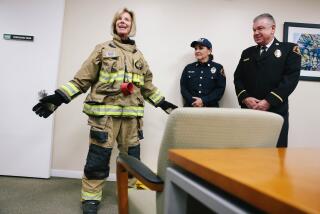Fashion 88 : For Some Modern Nurses, Clara Barton Look Is Out
- Share via
A nurse in a miniskirt? In shorts? In vivid fuchsia and purple? Though Clara Barton might not have approved, angels of mercy come dressed in different styles and colors these days.
Women nurses say the way they do their jobs, not the way they dress, determines whether they’re good nurses.
But some administrators are concerned that a registered nurse dressed in a polo shirt, white jeans and Reeboks--the unofficial uniform for nurses in Southern California--isn’t projecting a professional image.
Such relaxed attire “reflects a casualness and a lack of professional values,” asserts Toni Sullivan, chairperson of the department of nursing at USC.
She also notes, however, that nurses all over the country, both male and female, have faced an uphill battle trying to win the respect of doctors and patients, and many feel that the white uniform has gotten in their way. As Sullivan points out: “The old starched look carries with it some baggage of being authoritarian and, paradoxically, of being just an order taker, not a thinking professional. Neither extreme presents the image we want to aspire to.”
Finding the Middle Ground
Finding the middle ground--a look that projects a professional image, meets the functional requirements of the job and yet expresses some form of individuality--hasn’t been easy for nurses. Some, like Jody McCabe, a registered nurse at Memorial Medical Center of Long Beach, stopped shopping in traditional uniform stores and opted to buy street clothes that met their needs.
“I don’t like to wear one look, so I would go to Nordstrom and buy a nice white skirt and bright tops,” McCabe explains. “I wouldn’t shop at uniform stores because the clothes were boring. And housekeepers and secretaries wear the same uniforms as nurses, so there’s no way of distinguishing the professionals.”
McCabe is back in uniform now, but she’s still not wearing all white. In fact, she and dozens of nurses at Memorial are wearing fuchsia and turquoise blouses with khaki or navy pants and skirts, or they’re wearing bright purple or red “scrub suits”--all from a new uniform store right in their hospital.
The uniforms, designed by Cheryle Van Scoy-Mosher, a registered nurse and nursing-apparel designer, are part of a program spearheaded by Christine Pappas RN, vice president of nursing at Memorial, to introduce sophisticated apparel in the hospital.
“Patients tell me, ‘You don’t look like a nurse,’ ” says a pleased McCabe, who adds that she isn’t put off by prices like $62 for a navy blue uniform, even though a traditional nurse’s uniform costs from $20 to $40.
But other nurses, such as Patty Faustner RN, an 18-year veteran at Memorial, says the new uniforms are “too expensive and aren’t designed for all shapes and sizes. I’d rather go back to all white than wear those things.”
Until the late ‘60s, nurses wore white uniform dresses, hose and nursing shoes, and, of course, the symbolic white cap. Enter the women’s movement and the look started changing. The cap was the first element to go.
“The focus became what’s in the head, not what’s on it,” Sullivan explains. Pappas remembers her bedside nursing days, when her cap “was always getting caught in the various hospital rigging.” McCabe recalls that she wore her hat on graduation day and never put it on again. “It has absolutely nothing to do with the profession of being a nurse,” she says.
Anna Omery, an assistant professor at UCLA’s school of nursing, explains that originally the nurse’s cap was worn to keep hair out of the face: “In those early days almost every nurse had long hair--today the cap’s function is gone.
“Now the symbol of the profession depends on the nurse’s duties. For some it’s the stethoscope, for others it’s a pediatric smock. Subspecialties have become so specific that a nurse’s ‘symbols’ reflect her function,” Omery says.
Today, UCLA and many other nursing schools do not award caps upon graduation.
When it comes to shoes, athletic shoes are the current favorite alternative to traditional nursing styles. Administrators turn up their noses, but can’t fight the nurses who insist that these shoes provide the most comfort.
“Athletic shoes are comfortable. We allow them. But if a lawyer showed up in the courtroom in Reeboks, you’d question his professionalism. I think it’s the same for nurses,” Pappas says.
Linda Searle, director of nursing at Santa Monica Hospital Medical Center, points out that nurses in patient-care areas of her hospital are allowed to wear low-cut athletic shoes, but the dress code draws the line at high tops. “They just don’t look professional,” she says.
Lucia Brandt, an RN and the assistant director of the emergency department at Santa Monica Hospital Medical Center, says she wears pants and washable athletic shoes most days. “I feel more comfortable being casual, but I never feel that I’m not professional.”
However, Brandt has had to reprimand some of her staff for being too casual. “One woman showed up in something that looked like a white tutu--she was sent home to change. Generally I don’t care if skirts are above the knee, as long as they’re functional. That one wasn’t,” she says.
Arlene Ucinski, a registered nurse in the cardiac rehabilitation department of Cedars-Sinai Medical Center, says she often wears white shorts and a T-shirt with a cow in running shoes pictured on the front, because, she says, “It makes the patients feel more comfortable and puts them in better spirits.”
She’s quick to point out that what she wears is consistent with what she does: helping outpatients work on athletic equipment. In addition to monitoring their hearts, she may be called upon to demonstrate exercise equipment or help lift patients from machine to machine. “When I worked at bedside, I wore white overalls and colorful T-shirts.”
Working with students on a university campus means street clothes and a lab coat to registered nurse Nancy Sears, triage nurse at UCLA student health center. “I like to be able to wear colors, but the white lab coat lets the students know that they’re talking to a professional.”
A 1985 study of emergency-room nurses conducted by Annie Crafter Hoffman, RN and former director of nursing at UCLA’s emergency center, led her to allow nurses to wear street clothes with lab coats.
“We found that by wearing uniforms, nurses were treated in a subservient manner by physicians,” says Hoffman, now a staff nurse at Midway Hospital in Los Angeles. “Nurses were treated with more respect in street clothes and a lab coat. Being given the choice of what to wear was good for their self-esteem.”
But now in that same emergency center, current nursing director Genell Lee says nurses have been told to wear white uniforms again, after several years in street clothes. Turquoise warm-up jackets are optional.
“We got complaints from patients who didn’t know they had seen a nurse the whole time they were here. Obviously they had, but they weren’t able to identify them,” Lee explains.
“Identification is critical,” says registered nurse Debbie Lipstate, office manager for the Family Health Center at UCLA. “If a nurse is not identifiable as a member of the health care team, patients lose confidence.”
As a nurse practitioner, a professional position whose expanded duties lie between those of an RN and a physician, Lipstate says she wears street clothes and a lab coat to meet patients. Registered nurses in her unit are dressed in white, following a dress code designed by the nursing staff.
“I feel pretty strongly that you can’t tell professionals how to dress,” says Jane Ramseyer, director of nursing operations at Cedars-Sinai, where an advisory board of nurses helps form the dress code.
“Nobody wants to look bad on the job and no one purposely goes against the guidelines, but sometimes they need to be reminded about what is professional and what is not,” Ramseyer says.
USC’s Sullivan says national eyes are always focused on California when it comes to nurses’ dress. “We are always in the forefront and always are more liberal than almost any other area of the country. In many East Coast hospitals, the nurses still wear caps and starched uniforms. But that doesn’t mean they’re more professional.”
Exactly what dress is most professional for nurses is a “moot issue” UCLA’s Omery says. “Function is the only important qualification. As a nurse becomes more and more professional, she dresses to suit her function. She knows what her needs are.”
More to Read
Sign up for Essential California
The most important California stories and recommendations in your inbox every morning.
You may occasionally receive promotional content from the Los Angeles Times.













